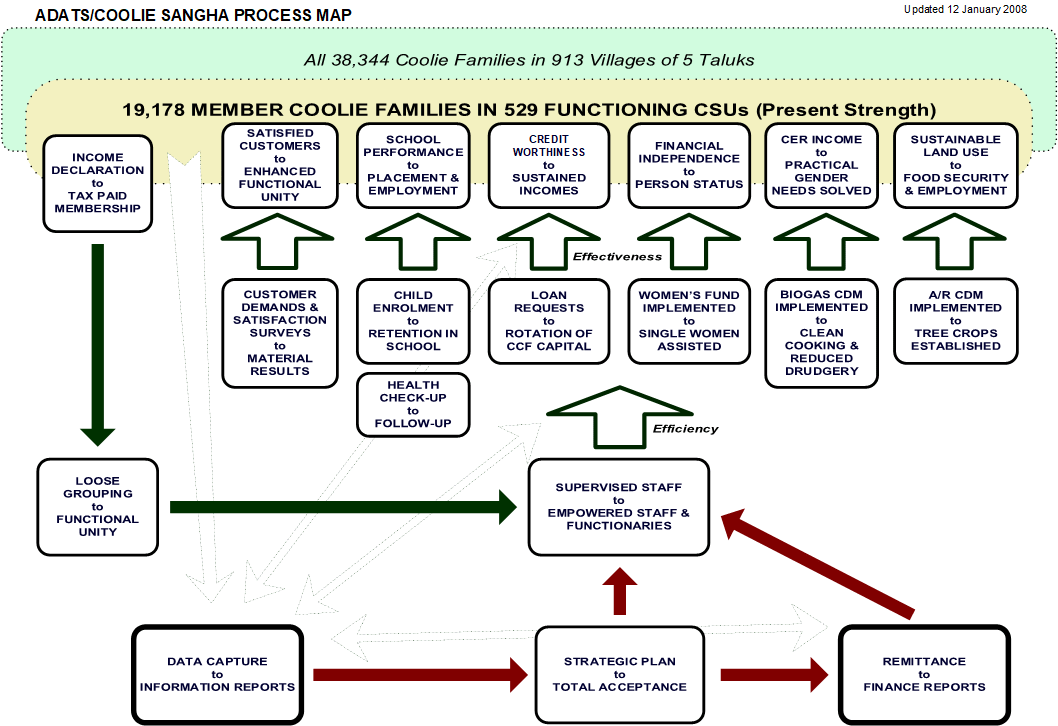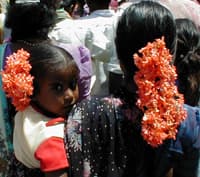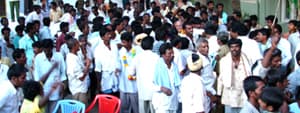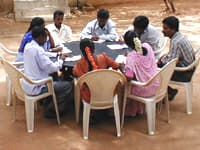Results / Effects

(Achievements as on March 2005)
A. Experience of Upper Caste Manipulation Ended

It is very pretentious for any NGO propped people's organisation to set itself an agenda to destroy the caste system which has been around for thousands of years. It is also a universal truth that it is impossible, through pressure or persuasion, to prevent the perpetuator from perpetuating. One cannot expect the upper castes to stop manipulating.
Challenging the caste system and refusing to allow it to influence one's own day to day living is a personal choice which can be made by individuals. When such individual choices are collectively made by thousands of families belonging to ALL castes and communities, spread over a wide and contiguous geographic coverage, it will weaken the ideological, demographic, and gender base of village society. This is a more sober and plausible objective.
Such a challenge needs a shift in the locus of control. Persons belonging to lower castes must realise that it is not what "others are doing to them" that can be changed, but what "they permit others to do to them". Then they can shake off the psyche of being manipulated. When that happens, there will be dramatic demonstrations of tangible change.
When we examine 4 Sub Effects indicators, this is exactly what we find the Coolie Sangha as having achieved. At a time when fundamentalism and communalism are fast becoming the order of the day, Member Coolie families have effectively challenged dictates of the caste system.
Villages with CSUs are perhaps the only ones in Karnataka where Harijana school cooks are now called to cook for village functions and festivals. Under these circumstances, to speak of children from middle and upper castes not eating midday meals cooked by 160 Harijana cooks in these 5 Taluks is quite redundant. The taboo has been shattered, and occupational reverses have taken place.
Inter-caste marriages have come to be generally accepted in villages with CSUs. The situation has been totally turned on its head. Not only are the numbers rising, but many parents actually support inter-caste choices made by their children, and Brahmin priests perform the ceremonies. Even non CSU families have come to accept inter-caste marriages.
Yet nobody "arranges" inter-caste marriages by searching for the best boy/girl suited for their daughter/son. This is because supporting inter-caste marriages demands a public snub to the caste system. Upward mobility in contemporary India demands an adherence to the "reality" of the caste system. Member Coolies do not want to go out of the way to threaten their advancement by consciously inviting censorship. However, this does not prevent them from supporting individual choices made by young couples. It is a matter of time before "arranged inter-caste marriages" become commonplace.
1,557 Coolie youth are in various skill-based jobs. They earn respectable monthly salaries and send moneys home. All of them maintain their links with the village/family and this has resulted in a demographic shift in village society. An increasing number of Coolie families are shedding their debilitating dependence on Ryots and forging new alliances with others. A sure precursor for destroying feudal ties and ushering in democracy.
ADATS needs to do much more to enhance and systematise our work with Coolie youth.
675 single women successfully run petty businesses. A few cultivate their own lands and one is employed as a cook in a government hostel. They have built houses and bought lands. These women are able to involve themselves in all forms of social activities. 123 married women have learnt from their courage and daring. Many have started their own business and are managers of happy homes.
B. State Welfare Resources Accessed

Reengineering ad hoc struggles for government benefits into a structured activity process was rather clever. By focusing on Results (as defined by the customers themselves), it has forced the hands of bureaucrats and politicians to abandon the trick of offering platitudes. It provides inarguable measurement to base negotiations upon.
A refreshing and brand new culture of governance is being introduced in a wide geographic belt. Never before could the governed say that 59% of their requests were met; or the governors claim that 32% of demands were under action. That the seeds for such a fundamental change have been sown by a people's organisation is telling in itself.
Besides an impressive list of individual and community benefits, the Coolie Sangha has, in just 2 years, ensured that 1,795 families now live in better houses.
Bribe taking has been brought to near ZERO in the delivery of basic services. It still prevails, but without government officials claiming a god given right to siphon off moneys. Instead, a rather mixed picture of government officials and village CSUs continually playing cat and mouse, with the former trying to get away with whatever they can, has emerged in these 5 Taluks.
But the Coolie Sangha has not seriously attempted to influence the type of welfare measures meted out by the government, or even procedures guiding their implementation.
With an altering of the power balance within village society, the Coolie Sangha has accumulated considerable clout and socio-political presence at the Taluk level. Over time, and in a considerable section of the membership, this has built an unshakeable loyalty. Non CSU families have come to accept the presence and efficacy of the village CSUs.
C. Family & Social Development Delivered by Coolie Women

Patriarchy gives women a pseudo status in society at large. In fact it is in middle class society's enlightened self interest to project a courteous demeanour of polite chivalry. To a much lesser extent, women are respected within their immediate community. Roles are assigned to them and the vernacular is tolerant. But to gain recognition within their own families is an uphill task. And finally, to express individuality is to border on heresy. Caste is an unique contribution that Indian society additionally offers to the arsenal of patriarchy.
The Mahila Meetings have, over the years, taken the bull by the horns and worked hard to strengthen the position of women within their families. They have gone further to help women develop an individuality. This is a double edged objective, because if not consciously placed in a feminist perspective, it can easily be abused to merely increase the work load of Coolie women.
The Mahila Meetings have effectively stopped domestic violence and ushered in a climate where it will not be tolerated. They have created an enabling environment for women to get property rights.
Coolie women have NOT been strengthened in their traditional role as care givers and health providers, following the classic NGO approach. Instead, they have been emboldened to pay attention to their own bodies. This has resulted in all reproductive ailments being attended to, family planning operations conducted on their terms, etc.
The Mahila Meetings have got the government schools to work. Their (largely) self-financed efforts to school Coolie children has an impressive success rate. 67% of 34,990 Coolie children are either still studying or have completed schooling. Girls constitute 44% of high school strength. Attrition rate is acceptable. Dropout rates are low.
Early marriages have been all but stopped. The average age of marriage has climbed 2-3 years higher than the legally prescribed minimum.
Elected women functionaries have fared on par with their male counterparts. The Mahila Meetings exercised total control over Sangha Funds and have done an excellent job in diligently spending moneys on various CSU activities.
But Coolie women elected to the Gram Panchayats did not fare much better than men. In fact, only 50% of them stayed unshakeably loyal to the CSUs, as compared to 65% men. This was a cause of grave concern and bitter disappointment in the Mahila Meetings. Though they are a formidable lot as a body of Coolie women, this did not automatically translate into each and every individual woman being a "better person".
The achievements of the Mahila Meetings appear in total reversal of the dictates of patriarchy, as enumerated at the start of this commentary. Thousands of Coolie women have developed an individuality and many more are poised to follow. They have obtained a genuine status as managers within their families. The gender integrated approach of the Coolie Sangha has strengthened their position within the community. But as actors in wider society, they did not behave any different from men.
E. Diversified Income Flows Established
Learning in this Effects Monitoring exercise has been more on the instrument that will enable Coolie families to diversify their income, than on any diversification itself. This is because there has been no major shift away from agriculture and into petty enterprise. We do not find NON-FARM ventures being taken up by Coolie families. However, over the past 11 years, there is a doubling of income from off-farm ventures.
We have examined 7 Sub Effects indicators, all of which tell us that the only way to achieve a shift is by making the village CCFs work properly.
Though there hasn't been any major shift away from agriculture and into petty enterprise, an increasing number of Coolie youth are setting up self-employment units. In spite of their ad hoc efforts not working out all that well, the trend still continues. We have no clue as to where it will lead. Perhaps it is a precursor, maybe not.
SC/ST and Muslim youth do not seem to benefit from skill training as much as middle and upper caste Coolie youth. They seem to have an inherent disadvantage in getting/keeping jobs. We haven't worked out why.
There appears to be a far greater promise in the number of Coolie women in non-traditional employment. 459 of them face success and failure just like men, and still plod on. Most importantly, they become family managers with control over family finance and decision making, even when they have men folk at home.
This Effects Monitoring exercise has proved beyond a shadow of doubt that Banks have a pro-rich bias. 80 banks that operate in these 5 Taluks together gave out 31,253 loans worth ₹ 1,383 million these past 2 years. The entire Coolie caste-class (not just CSU Members) borrowed 0.6% of the total lending by institutional finance.
With such a strong bias, village CSUs have no choice but to make their decentralised village level Coolie Credit Funds function efficiently and use them as entry level instruments to start enterprising. Efforts to introduce fiscal discipline will, in the meanwhile, take time to get internalised. This has to be a grassroots decision by the Coolie families themselves since no outside prescription has worked.
After 20 long years of a fetish denial, we finally admit that 22% of the CCF capital is lost. 75% of the present CCF Overdue will, at least for the time being, not come back. Due to an obsession with the Overdue problem, 48% of the total CCF Capital remains unused as bank balances. Exposed Portfolio Rate and Delinquency Rate have both shot up to 48%. This is terribly demoralising for the credit programme as a whole. No argument of conservative caution can justify such a situation. We now have plans to restart/rejuvenate the decentralised village CCFs.
F. Coolie Lands Systematically Conserved & Cultivated

Member Coolie family income has definitely gone up. A combination of agricultural labour and farming has contributed to this improvement, in spite of 4 years of continuous drought.
The percentage of desperately poor families who earned less than ₹ 3,000 a year has drastically fallen these past 2 years, once again in defiance of the drought. Where there were 4-8 persons out of 10 who claimed to be in utter destitution, there are now just 2.
Disposable wealth has also increased. At least 43% of the 64,890 acres owned by Coolie families have a value close to par with that of richer peasants. In just 2½ years, landlessness has dropped from 12% to 8%.
15 years back, not a single person from the Coolie caste-class was within the ambit of productive credit. They did not cultivate lands and were not engaged in any off-farm activity. The only reason they borrowed was for pressing consumption emergencies. This created a debilitating dependence on middle peasant Ryots. Today, cases of punitive money lending with associated feudal excesses have all but disappeared.
Quite surprisingly, this has happened in spite of a less than optimal fiscal performance of the village CCFs. This goes to show that the village CCFs were not a total washout insofar as empowerment was concerned. But money lending with prohibitive interest rates has crept into the villages. The only way that Coolie families can get out of the newly emerging debt trap is by running their village CCFs efficiently.
There has been a drastic shift away from cash crops to food crops, but not because of any project effort. It remains to be seen if Coolie families will continue with a balanced crop choice even after the drought is over, or whether they will succumb to market temptation.
G. Critical Project Output : Coolies United across all Divides

There has been a steady annual increase in the number of villages as well as families these past 11 years. 18% of the total population of these 5 Taluks are active Members in 863 village CSUs. Within the 434 villages with functioning CSUs, their population coverage is much higher at 34%.
Village CSUs have organisational savings that total to an impressive ₹ 49.2 million. There was a decline in the growth rate of Sangha Funds over the past 3 years due to poor movement in the Coolie Credit Funds. Member Coolie families have realised that it is an open and transparent grassroots mechanism of collecting and spending moneys that will guarantee the continuity of core CSU activities, and not an arbitrarily arrived at quantum of money.
Inner democracy is strong and elected functionaries work with a high degree of efficiency. The village CSUs elect new persons every other year and ensure that over dependency on individuals is not developed.
Population coverage gets converted into votes and electoral strength. CSU control over the Gram Panchayats vastly enhanced their socio-political clout and ability to access State resources.
The Coolie Sangha has active as well as inactive Member families. Not all of them are adversaries simply because they didn't pay Sangha Tax and renew current year membership. Many can be counted upon during major socio-political struggles. We use an extremely complex and time-tested algorithm to calculate "Sure Votes" at 25% of the total electorate in Bagepalli Taluk, 13% at Chickballapur, 15% at Chintamani, 21% at Siddalaghatta, and 16% at Gudibanda Taluk.
There were huge Taluk to Taluk variations in the performance of CSU candidates in the recently conducted GP 2005 elections. In the northern Taluks, the village CSUs emerged as undisputed leaders of their alliance. But in the southern belt, though the alliance was once again swept to power, many village CSUs did not even put up their own candidates. Over the past 5 years, they have become a captured vote bank that their allies take for granted. It remains to be seen if the village CSUs have learnt any lessons.
Insofar as being able to usher in a genuine grassroots democracy, results have been rather mixed. The electoral behaviour of 43% of the 168 GP 2000 Members who won as CSU candidates was not very different from that of other GP Members. This was cause for deep disappointment, and could be the reason why 3 of the 5 Taluks did not take the GP 2005 elections as seriously as they ought to have.
We have come to suspect that perhaps the fault lies with us. Due to an NGO aversion, we stay away from electoral politics. We are content to merely record, monitor and draw conclusions. But what is this hands-off policy if not judgemental? Those winning GP elections need our constant support and guidance to see them through those moments that we highhandedly term as mainstream pressure. Far more training, joint reflection and resources are needed for them to do their job with a difference. For that to happen, we have to sharpen much more than our ability to criticise. We too have to get our hands dirty. Part-time politicians are ineffective. The armchair variety are outright dangerous.
H. Critical Project Output: Staff & Functionaries Empowered to Deliver Results

ADATS Staff have moved away from being supervised staff to empowered actors. They receive performance salaries every month. Their continued employment is determined by upward appraisals by their Customers — the Member Coolie families.
Most Staff understand management as a means to focus more on individuals. Some rightly ask whether there is no value in working with the Coolie caste-class as a whole. Rhetoric and slogans were, after all, what created a huge base of empowerment over the past quarter a century. It created the "big" results. It altered the power balance in village society. It provided Coolies with a person status and identity. It resulted in a larger unification of the poor. Overall wages rose and women got equal wage as men. It placed thousands of children into schools.
In our view, the 2 are complementary. Efficient service delivery is impossible without the enabling milieu created through empowerment. While the former needs good process management and the production of Results, the latter entails wider struggles, shows of strength, political education and conscientisation.
